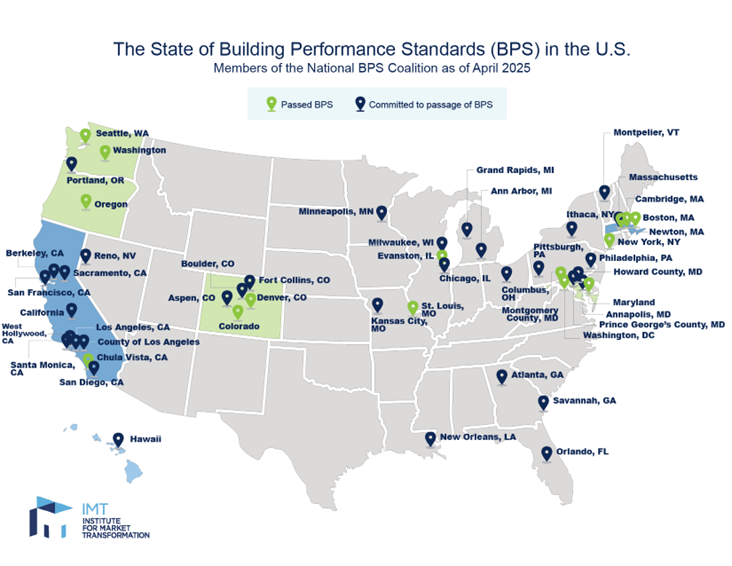Turning Compliance into Opportunity: Your Road Map to Building Performance Standards
With building performance standards (BPS) gaining momentum nationwide, proactive planning is key. Discover how early action and expert guidance can reduce risk, cut costs, and future-proof your business.
This Week's Contributor

Turning Compliance into Opportunity: Your Road Map to Building Performance Standards
Taking Early Action on Building Performance Standards to Mitigate Risk
The building sector is the largest contributor to greenhouse gas emissions, and achieving national and global climate goals requires large scale action by improvements in building performance. BPS regulations are designed to support progress on this imperative.
While BPS vary significantly across the US, they typically require regular robust reporting on performance and set a maximum amount of energy used or GHGs generated per square foot of space. Non-compliance with BPS can be expensive. As an example, under the Clean Buildings Performance Standard in Washington State fines can be $7,500 for a 25,000 sq. foot property.
With compliance timelines approaching quickly, it is crucial to take proactive steps to establish energy baselines and identify the necessary upgrades to meet requirements.
Understanding Where Your Property Falls Within the Emerging BPS Landscape
Many jurisdictions have implemented benchmarking requirements that set the stage for the emergence of BPS. If you have properties that are subject to benchmarking compliance, expect BPS to follow. Do you own or manage properties in the cities or states shown on this map with active BPS or formal commitments to implement them? If the answer is yes, keep reading to understand which steps you should take to comply.
Identifying Your Building Performance Standards Requirements
Understanding and meeting BPS requirements is essential for property owners and managers aiming to enhance energy efficiency, reduce emissions, and avoid significant non-compliance penalties. Follow these steps to streamline the process and set your properties on the path to compliance.
- Pinpoint relevant jurisdictional regulations. Begin by assessing which specific BPS regulations apply to your properties. These standards vary by city, state, and even regional mandates. It is vital to determine whether your properties are in jurisdictions with active requirements or forthcoming commitments. Review publicized guidelines to understand benchmarks, reporting requirements, and any penalties tied to non-compliance. Some jurisdictions even provide maps or online tools to help property owners quickly identify their obligations; utilize these resources to stay ahead of regulatory changes.
- Benchmark current energy performance. Conduct an energy benchmarking analysis to establish a clear baseline for your building’s energy use intensity or greenhouse gas emissions. This not only provides critical insight into your building’s current performance relative to applicable thresholds but also highlights inefficiencies that could be addressed through upgrades or operational changes. Ensure that benchmarking efforts are thorough and compliant with the jurisdiction’s specific methodologies to avoid delays or errors in reporting.
- Identify gaps and develop a compliance plan. After benchmarking, compare your building’s performance to the applicable standards. For properties that fall short, identify the gap; are they due to outdated systems, operational inefficiencies, or both? Collaborate with sustainability experts to conduct energy audits to pinpoint actionable measures. Additionally, evaluate the cost-effectiveness and feasibility of various upgrades, from high-efficiency HVAC systems to renewable energy installations, as part of your long-term compliance strategy.
- Consult Experts for Tailored Solutions. Leverage professional expertise to simplify the complexities of BPS compliance. Partner with sustainability experts, such as APTIM, who can clarify nuanced regulatory requirements, forecast the financial implications of non-compliance, and design customized roadmaps for achieving performance targets. A trusted advisor can also stay updated on emerging policies, ensuring your compliance plan remains relevant and robust.
By following these steps, you can transform BPS compliance from a challenge into an opportunity, positioning your properties for greater energy efficiency, regulatory alignment, and long-term success.
Expert Guidance for Every Step of Your BPS Journey with APTIM
APTIM’s team of experts can help you navigate BPS by identifying which properties are subject to BPS, clarify compliance requirements, evaluate financial implications of non-compliance, conduct energy benchmarking, perform ASHRAE compliant energy audits, and develop actionable road maps to meet sustainability goals.
Learn more about APTIM’s sustainability solutions.
Published July 2025
APTIM. In Pursuit of Better.
Connect with APTIM
Subscribe to the APTIM Xchange Newsletter
APTIM's newsletter, The APTIM Xchange, provides industry news flashes, regulatory updates, service spotlights, and topical columns from our subject matter experts.
